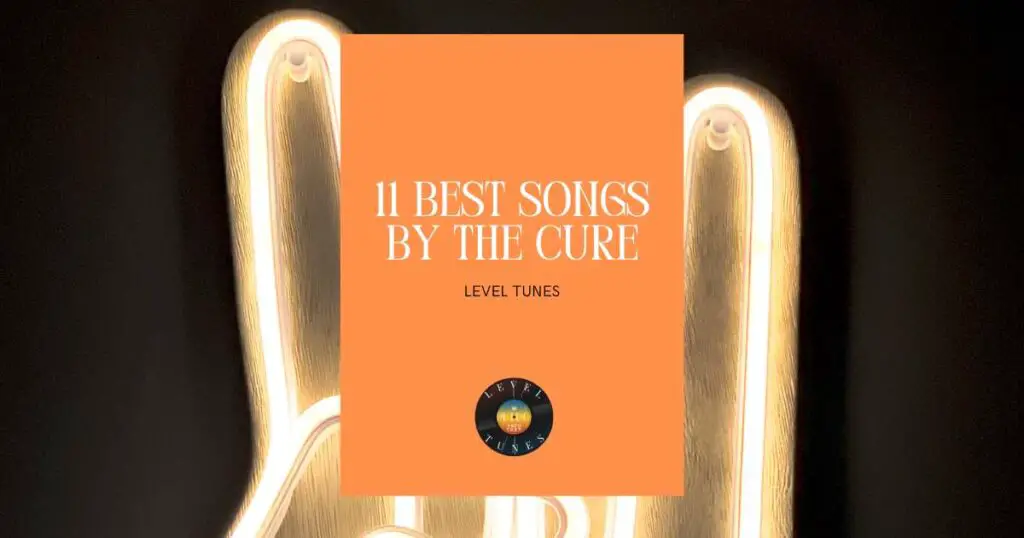11 Best Songs by the Cure: A Must-Listen List!
Hey everyone, it’s TBone here from Level Tunes, your go-to DJ and music aficionado! Today, I’m beyond excited to share something special with all you fellow DJs and music lovers out there – my handpicked list of the 11 best songs by The Cure.
Why The Cure, you ask?
Well, as a lifelong fan of their unique sound that perfectly blends post-punk, goth, and new wave, I believe their music isn’t just timeless – it’s transformative.
Each track in this list is a journey through the heart and soul of The Cure, showcasing their incredible range and emotional depth. Whether you’re a die-hard fan or just getting into their music, these songs are essential listening.
So, turn up the volume and let’s dive into the magical world of The Cure together!
Here are the best Songs by the Cure that you can check out:
List Of Best Songs by the Cure
Best Songs by the Cure in a list format:
“Boys Don’t Cry” (1979, Fiction Records)
From their album “Three Imaginary Boys,” “Boys Don’t Cry” is a post-punk classic that showcases The Cure’s raw early sound. Released in 1979 under Fiction Records, this track stands out for its catchy guitar riffs by Porl Thompson and bass lines by Michael Dempsey. Robert Smith’s vocals convey a mix of vulnerability and defiance, challenging the stereotypical norms of masculinity. I chose this song for its timeless message and its upbeat, yet emotive melody that resonates with so many.
“Just Like Heaven” (1987, Fiction Records)
Featured on the 1987 album “Kiss Me, Kiss Me, Kiss Me,” “Just Like Heaven” is a quintessential The Cure song, blending dreamy melodies with heartfelt lyrics. Smith’s storytelling in this song is captivating, painting a picture of love and longing. Simon Gallup’s bass and Boris Williams’ drums provide a rhythmic foundation that’s both uplifting and melancholic. This song is on my list for its perfect balance of pop sensibility and deep emotional undercurrents.
“Lovesong” (1989, Fiction Records)
From the album “Disintegration,” “Lovesong” stands out for its hauntingly beautiful melody and deeply personal lyrics. Released in 1989, it’s a testament to Robert Smith’s songwriting prowess, offering a more tender and introspective side of the band. The blend of Roger O’Donnell’s keyboard with Smith’s expressive voice creates a soundscape of love and devotion. I included this track for its ability to capture the essence of love in its purest form.
“Friday I’m In Love” (1992, Fiction Records)
This track from their 1992 album “Wish” is a jubilant departure from The Cure’s typically somber tone. “Friday I’m In Love” is infectious with its upbeat tempo and playful lyrics, showcasing a lighter side of the band. Perry Bamonte’s guitar work adds a bright, poppy feel that’s hard to resist. It’s on my list for its universal appeal and the way it can instantly uplift anyone’s mood.
“Pictures of You” (1989, Fiction Records)
Also from “Disintegration,” “Pictures of You” is a sprawling, epic track that delves deep into nostalgia and loss. The song features some of Smith’s most evocative lyrics, backed by a lush, atmospheric sound. Simon Gallup’s bass lines weave through the song, adding depth and emotion. This song is a must-listen for its powerful portrayal of memory and longing.
“A Forest” (1980, Fiction Records)
“A Forest” is a standout track from their 1980 album “Seventeen Seconds.” It’s a dark, mesmerizing song that perfectly captures The Cure’s early gothic sound. Lol Tolhurst’s drumming sets a moody tone, while Smith’s haunting vocals and mysterious lyrics create an enigmatic allure. I chose it for its hypnotic rhythm and its role in defining the band’s early sound.
“The Lovecats” (1983, Fiction Records)
Released as a standalone single in 1983, “The Lovecats” is a fun, jazzy departure from The Cure’s typical style. This song showcases their versatility and ability to experiment with different genres. The upbeat piano and double bass, coupled with Smith’s playful lyrics, make it a unique and memorable track. It’s included for its whimsical charm and catchy melody.
“In Between Days” (1985, Fiction Records)
From the album “The Head on the Door,” “In Between Days” is a perfect blend of post-punk energy and infectious pop. Released in 1985, it features upbeat tempos and optimistic lyrics, contrasted with an undercurrent of melancholy. Porl Thompson’s guitar work in this track is particularly noteworthy. This song is a favorite for its vibrant energy and poignant lyricism.
“Fascination Street” (1989, Fiction Records)
Another gem from “Disintegration,” “Fascination Street” delves into the darker, more brooding aspects of The Cure’s sound. The song is driven by Gallup’s powerful bass and Williams’ intense drumming, creating a sense of urgency and intrigue. Smith’s vocals are at their most commanding here, making it a standout track for its intensity and atmospheric depth.
“Lullaby” (1989, Fiction Records)
Also from “Disintegration,” “Lullaby” is one of The Cure’s most haunting songs. Its eerie lyrics and mesmerizing melody create a chilling, dreamlike quality. The intricate interplay of guitar, bass, and keyboards crafts a sound that’s both captivating and unsettling. I included “Lullaby” for its masterful storytelling and its ability to transport listeners to another world.
“Close to Me” (1985, Fiction Records)
Featured on “The Head on the Door,” “Close to Me” is known for its distinctive use of horns and a claustrophobic, insistent rhythm. Smith’s introspective lyrics and the song’s innovative arrangement make it a standout track. It captures a sense of intimacy and vulnerability that’s rare and compelling. This song rounds out the list for its emotional depth and memorable melody.
Fun Facts: Best Songs by the Cure
“Boys Don’t Cry”
- Origin of the Title: The title “Boys Don’t Cry” wasn’t initially about challenging gender norms. Robert Smith stated it was a reflection of his own tendency to hide his emotions.
- Musical Influence: This song was heavily influenced by the post-punk scene, especially bands like Joy Division, showcasing a more upbeat and jangly sound in contrast to their darker themes.
“Just Like Heaven”
- Inspiration: The song was inspired by a trip Robert Smith took with his girlfriend, Mary, to Beachy Head, England. The lyrics reflect the memories and feelings from that day.
- Cover Versions: “Just Like Heaven” has been covered by numerous artists, including Dinosaur Jr. and Katie Melua, showing its wide appeal across different musical genres.
“Lovesong”
- A Wedding Gift: Robert Smith wrote “Lovesong” as a wedding present for his wife, Mary Poole. They have been together since school and she has been a significant influence on his music and life.
- Chart Success: This track reached number 2 on the Billboard Hot 100 in the United States, making it The Cure’s highest-charting single in the country.
“Friday I’m In Love”
- Unusual Creation: Robert Smith believed he had inadvertently plagiarized the melody after waking up with it in his head. After playing it to the band and finding out it was original, they recorded it.
- A Different Day: Despite its title, “Friday I’m In Love” was recorded on a Tuesday. The song is known for mentioning different days of the week, except for Saturday.
“Pictures of You”
- Literal Interpretation: The song was inspired by an incident where Smith’s wallet containing pictures of his wife was destroyed in a fire at his house.
- Music Video: The music video for “Pictures of You” was filmed in freezing conditions. The band performed surrounded by ice, reflecting the song’s emotional chill.
“A Forest”
- Live Favorite: “A Forest” is known for its extended live performances. The band often stretches the song with elaborate instrumental sections, making each live rendition unique.
- Innovative Sound: This song marked a significant shift in The Cure’s sound, introducing a more atmospheric and moody style that would become their signature in the 1980s.
“The Lovecats”
- Jazz Influence: The song was The Cure’s first and most notable foray into the world of jazz and swing, showcasing their versatility as a band.
- Chart Performance: “The Lovecats” was one of The Cure’s first major commercial successes, reaching the top 10 in the UK Singles Chart.
“In Between Days”
- Vibrant Video: The music video for “In Between Days” is known for its bright, primary-colored socks worn by the band members, adding a quirky visual element to the song.
- Lyrically Ambiguous: The song’s lyrics have been subject to various interpretations, often seen as a narrative about love, loss, or possibly a reference to the fear of AIDS, which was a growing concern in the mid-1980s.
“Fascination Street”
- American Appeal: “Fascination Street” was specifically released as a single in the US, where it reached number one on the Modern Rock Tracks chart, reflecting the band’s growing popularity in America.
“Lullaby”
- Childhood Nightmares: The song was inspired by Robert Smith’s nightmares as a child, where he imagined spiders eating him. The lyrics convey a sense of fear and fantasy.
- Award-Winning Video: The music video for “Lullaby” won the British Video of the Year award at the 1990 Brit Awards.
“Close to Me”
- Unique Video Concept: The music video, directed by Tim Pope, features the band cramped in a wardrobe teetering on the edge of a cliff, eventually falling into the sea, symbolizing vulnerability and closeness.
And there you have it, fellow music enthusiasts – a journey through the captivating world of The Cure. We’ve explored their iconic songs, uncovered intriguing facts, and celebrated their musical genius. Keep these tunes spinning and let the timeless magic of The Cure resonate in your heart!
Thanks for reading.
TBone




